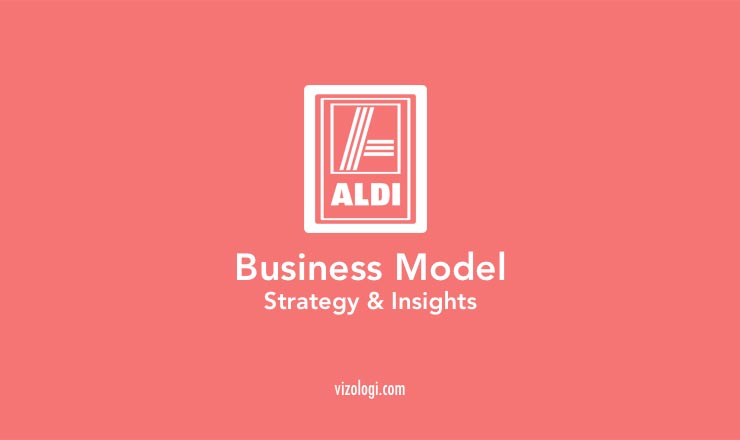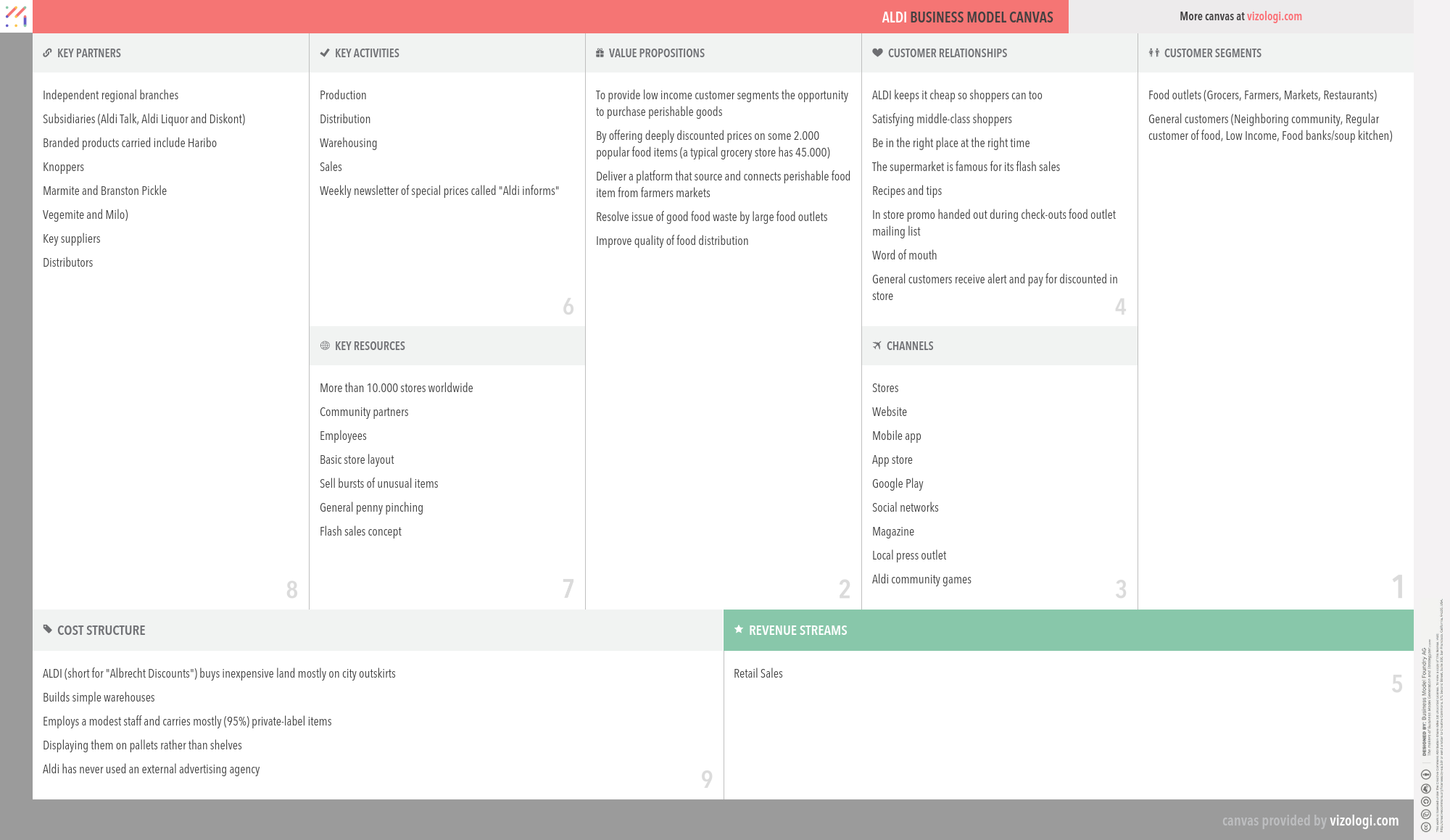ALDI BUSINESS MODEL | HOW DOES ALDI MAKE MONEY

Everyone loves shopping at supermarkets. More than the experience of shopping, what do customers like more than offers and cheaper goods? Here comes in Aldi, the leading global supermarket discount chain. Did you know that the Aldi chain was once part of a bigger ALDI brand?
ALDI, founded by brothers Karl Albrecht and Theo Albrecht in 1946, is the collective brand of two chief global supermarket discount chains. The estimated combined turnover is said to be more than €50 billion with over 10,000 stores in 18 countries combined. However, this chain was split into two different groups 14 years later in 1960. Aldi Nord, based in Essen is owned by Theo Albrecht and Aldi Süd, based in Mülheim is owned by Karl Albrecht. Aldi’s operations in Germany consist of Aldi Nord’s 35 individual regional companies with about 2,500 stores in Eastern, Northern and Western Germany, and Aldi Süd’s 32 regional companies with 1,600 stores in Western and Southern Germany.
While the national operations of both are impressive, the international operations are also really impressive. Aldi Süd operates in United States of America, Great Britain, Ireland, China, Hungary, Switzerland, Australia, Slovenia and Austria. Aldi Nord operates in United States of America, France, Denmark, the Iberian Peninsula, the Benelux countries and Poland. While Aldi Nord operates as Trader Joy in the United States, Aldi Süd operates as Aldi.
What are some of the business strategies of Aldi?
Few of the strategies and practices of Aldi are quite common in supermarkets in Germany while they are not seen or rather unique in other parts of the world. These unique practices include charging shoppers for shopping bags and the network of turnstiles and metal gates forcing the shoppers to exit through the checkout only. Let us now explore some of the business strategies of Aldi.
Aldi has the majority of Private labels than branded products.
Staple items like food, beverages, sanitary napkins, toilet paper and other inexpensive household items are the ones majorly sold in Aldi supermarkets. The surprising fact is that over 90% of the products are private-label products with the number of other brands limited to 2 or 3 brands for each product. More than increasing sales volume for each product, this step enables Aldi to pass the savings on to the shoppers as the role of middleman is nothing here. This has helped drive discounts and also avoid numerous price tags. Aldi’s private-label packaging is designed for easy scanning with its checkout systems.
Less advertising but still really effective.
The German supermarkets of Aldi do the least of advertising except publishing ‘Aldi Informs’, a weekly list of special prices and offers they hand out in stores or by mail. While in other countries like United States, Britain and Australia, advertising happens in print and television media.
The no-frills design and the restocking supply system are unique.
Aldi uses boxes instead of shelves, which enables the workers from not having to stock the shelves constantly. This means that once a product runs out, the shopkeepers simply have to replace it with a box. The resupply management is in such a way that the numbers of workers required are minimized too. A lot of products are arranged in such a way that new stock can directly arrive at the racks. The products are weighed and kept so that the cashier just has to bill it at checkout.
Shoppers are made to pay for bags and trolleys.
This novel method of saving bags was widely appreciated. Shoppers are asked to bring their own bags or else they have to pay small fees for it. They also have to pay a quarter deposits for using the shopping carts. Inside officials said that this shopping cart rental system is one reason why they are able to keep the costs of the products in Aldi very low.
The companies owned by Aldi which contribute to the Business Model.
The major subsidiaries of Aldi and also the revenue generators of Aldi other than the supermarkets are:
Aldi Talk.
MEDIONmobile or ALDImobile, popularly known as Aldi Talk is a mobile virtual network operator based in Germany (founded on 7 December 2005), Australia (founded on March 2013) and the Netherlands (founded on July 2009). Aldi Talk use Telefonica network communications in Germany, KPN in the Netherlands and Telstra in Australia.
Aldi Liquor.
Aldi not only sell low-cost products in the supermarkets but also sells low cost liquor from its liquor stores in Australia. Of all the varieties of liquor available, the whiskey from Aldi has been termed as phenomenal in the Melbourne International Spirits Competition.
Diskont.
Diskont are a group of no frills petrol stations, operational since 2009, by Aldi in a joint venture with petrol retailer Free Energy (FE) Trading GmbH through its subsidiary Hofer. There are 66 fuel stations on or nearby the stores, providing self-serve unleaded or diesel fuel.
Exploring the Business Model Canvas of Aldi.
Before getting into the detailed structure of the business model of Aldi and analyzing the important segments, let us look into how Aldi earns revenue.
How does Aldi earn revenue?
Having Own-Products in the stores.
Shoppers always wanted quality items at low cost. As a solution to this, Aldi started stoking up own-branded products than other mainstream products. This led to the fact that middlemen are no longer needed and hence they are able to save the cost of paying the middlemen which went into their revenue stream.
From its subsidiaries.
Aldi Talk, Aldi Liquor and Diskont supplies to the revenue stream.
Patent checkout system and payment for bags and carts.
Aldi uses checkout systems that were developed and patented by its German parent. In this new system, the conveyor belts are longer to lodge the entire contents of a trolley. All the products have bigger bar codes in three different positions which can be captured easily the first time it is scanned. This means that more customers can checkout in a given time frame when compared to other supermarkets which means that more revenue can be generated.
Business Model Canvas of Aldi.
Business model canvas of Aldi explaining the different aspects of a business model like customer segments, value propositions, channels, customer relations, revenue stream, key activities, key resources, key partners and cost structure are given below:
Click the image to enlarge.
Customer Segments: This denotes the people for whom Aldi is useful.
- Grocers, Farmers, Markets and Restaurants which depends on Aldi for their daily products.
- General customers who can only afford low-cost items like low income people, soup kitchens/food bank etc.
Value Propositions: What all problems can Aldi solve and what all do they have to offer.
- Since they serve low-cost items, they can provide low income customer segments the opportunity to purchase perishable goods.
- By offering deeply discounted process on some 2000 popular food items while a typical grocery store has 45000.
- Deliver a platform that source and connects perishable food items from farmers markets.
- Resolve issue of good food waste by large food outlets.
- Improve quality of food distribution.
Channels: What all are the platforms used by Aldi to reach the shoppers.
- Stores
- Websites
- Mobile App
- App store
- Google Play
- Social networking websites
- Magazine
- Local press outlet
- Aldi community games
Customer Relationships: Features offered by Aldi to connect with the customers.
- ALDI keeps it cheap, so customers can too.
- Satisfying middle-class shoppers due to the low-cost products.
- Being in the right place at the right time.
- The supermarket is famous for its flash sales.
- Recipes and tips.
- In store promo handed out during checkout, in the outlets and in the mail.
- Word of mouth.
- General customers receive alert and pay for discounts in store.
Revenue Stream: What are the main income sources?
- Retail Sales.
Key Activities: What are the activities undertaken by Aldi.
- Production
- Distribution
- Warehousing
- Sales
- The weekly newsletter of special prices and offers called ‘Aldi Informs’.
Key Resources: What all resources did Aldi use to be successful?
- More than 10000 stores worldwide.
- Community partners
- Employees
- Basic store layout
- Sells bursts of unusual items
- General penny pinching
- Flash sales concept
Key Partners: Who all help Aldi? What all do they do?
- Independent regional branches.
- Subsidiaries like Aldi Talk, Aldi Liquor and Diskont.
- Branded product carriers including Haribo, Knoppers, Marmite and Brandston Pickle, Vegemite and Milo.
- Key suppliers.
- Distributors.
- Cost Structures: What are the types and relative proportions of fixed and variable costs that Aldi incurs?
- ALDI (short for Albrecht Discounts) buy inexpensive land mostly outside city limits.
- Builds simple warehouses.
- Employs a modest staff and carries mostly private-label items.
- Displaying them on pallets rather than shelves so that refilling can be done easily and quickly.
- Aldi has never used an external advertising agency.
The future of Aldi
Aldi has made quite the footprint in the food retail industry exactly at the time when grocery shopping experience is undergoing an amendment in audience, service, and merchandising. By capturing the heart of the common folk, Aldi is a serious rival to grocery stores like Walmart, WMT, Whole Foods and even Amazon. Aldi is planning to increase the number of stores, especially in the United States to make the overall number of stores cross 2500.
The discount model of Aldi is seen to be the way of the future. The number of customers across different income levels is hoping to pay less for household items and grocery. With the demand for quality and freshness on the rise since ages, Aldi is creatively merging the two to create a cheap and unique shopping experience.
For hundreds of business model like this you can visit the marketplace provided by vizologi.com

Vizologi is a revolutionary AI-generated business strategy tool that offers its users access to advanced features to create and refine start-up ideas quickly.
It generates limitless business ideas, gains insights on markets and competitors, and automates business plan creation.



